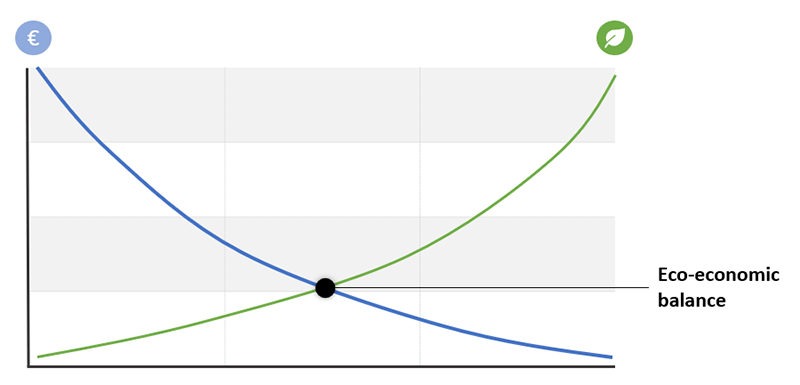
From FinOps to GreenOps: the key to a successful Green IT Strategy
The Imperative of Sustainability for Businesses
In today's rapidly changing global landscape, organizations face multiple challenges. Among these, sustainability has increasingly become one of the top concerns today and has emerged as a trend that is shaping the future of business. It's not just a buzzword, sustainability has become an imperative for companies across industries, driving innovation, reshaping consumer expectations, and influencing the very essence of how businesses operate.
Embracing sustainability is not just a moral obligation but a strategic imperative for businesses. It offers a wide range of tangible benefits. Some of the drivers for a sustainability strategy are:
- Cost reduction: sustainable IT practices can lead to cost savings through energy efficiency improvements, reduced resource consumption, and lower operational expenses.
- Regulatory compliance: many regions have implemented regulations and standards related to environmental sustainability. Companies must comply with these regulations to avoid penalties and legal issues.
- Market strategy: demonstrating commitment to sustainability aligns with corporate social responsibility (CSR) goals, enhancing a company's reputation and attracting socially conscious customers and investors.
- Competitive advantage: companies that adopt sustainable IT practices can gain a competitive edge by appealing to environmentally conscious consumers and partners.
- Innovation and efficiency: sustainability initiatives often drive innovation in IT, leading to the development of more energy-efficient technologies and streamlined operations.
Our vision: From FinOps to GreenOps
We have stated that economic, public, and regulatory pressure are driving companies to put sustainability as a key business goal. But the company strategy must be accompanied by an adequate response of IT departments. Overall, integrating sustainability into IT operations is not only an ethical choice but also a strategic one that can benefit the company's bottom line, reputation, and long-term success.
Sustainability is mainly about the best and most efficient use of the available resources. This requires IT departments to enhance performance in two ways:
- 1. Guarantee business operations at the lowest possible level of environmental impact, which is what we call Green IT.
- 2. Guarantee business operations at the lowest possible cost. This is commonly known as FinOps. But why is cost related with sustainability? Because sustainability is not a one-time investment, but a long-term commitment that must be, not only compatible, but enhance business outcomes and long-term financial stability.
IT departments must embrace a more comprehensive framework that interweaves economic viability and environmental stewardship. This is where Green IT, which seeks environmental efficiency, meets FinOps, which seeks financial optimization.
GreenOps
This is what we call GreenOps, a set of practices and principles aimed at guaranteeing operations not only at the lowest possible cost, but also the lowest possible environmental impact.
Sustainability cannot -and should not- go against operational efficiency. Investing in sustainability to later not be able to maintain said strategy in the long-term would be a waste of time and resources. GreenOps looks for the long-term, finding the best balance between operational and financial efficiency, and environmental impact.
There are usually two scenarios from a GreenOps perspective:
- 1. Optimization can often lead to the decrease of both cost and environmental impact. For example, through the shutdown of unused virtual machines and a better monitorization of the use of resources. Sometimes we leave environments running after a test, which keeps consuming energy and financial resources.
- 2. Sometimes investing in sustainable practices can lead to an increase in costs. For example, moving to a different region because its data centers are supported by renewable energy. The role of GreenOps is to find the balance between the benefits of a sustainable approach, and the costs incurred. Always taking into consideration the long-term financial well-being.

Figure 1: The second scenario is when investing in sustainability practices results in a decrease in financial benefit. The goal of GreenOps will be to look for the optimal equilibrium and best possible outcome.
Monitoring
It is paramount that all the initiatives and day-to-day operations are closely monitored by teams. Companies, and vendors, usually invest in solutions that monitor costs, but leave out energy and waste-related KPIs such as Power Usage Effectiveness (PUE), or UPS Energy Efficiency, to give some examples. GreenOps carries monitoring at its core, and combines and analyzes results to:
- 1. Make reasonable predictions.
- 2. Set the best strategy for a GreenOps approach.
Conclusion
The imperative of sustainability has risen to the forefront of business concerns, reshaping the way companies operate in our rapidly changing world. Sustainability is no longer just a trend or a moral obligation, but a pivotal element that is reshaping how companies operate while offering tangible benefits, from cost savings and risk mitigation to enhanced reputation and access to new markets.
To fully embrace sustainability, companies must integrate it into their IT operations to achieve full-term success in their strategy. The convergence of sustainability and efficiency is encapsulated in the concept of GreenOps, which is the term used to refer to the balance between operational and financial efficiency, and the lowest possible environmental impact. GreenOps seeks to optimize your existing IT environments and operations to achieve a more sustainable approach environmentally, but also financially. Therefore, GreenOps needs to support itself on the practice of FinOps, which will act as a key pillar in the IT sustainability strategy. Investment in sustainability must be accompanied by a long-term business plan in order to succeed.


